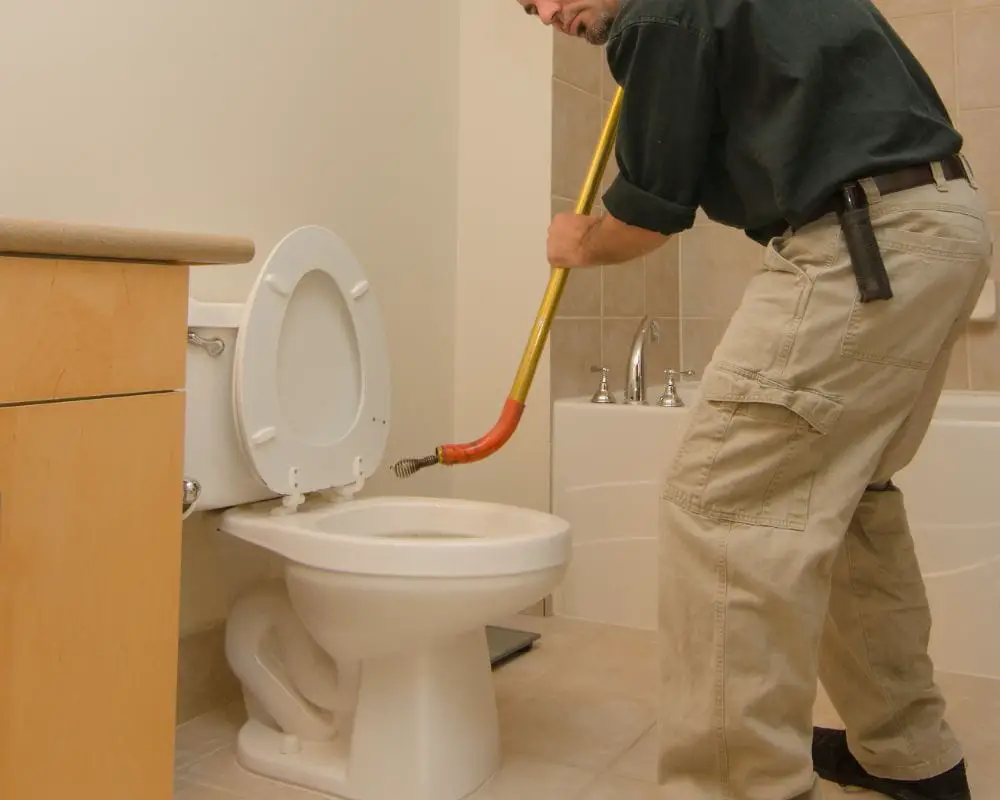Toilet Auger vs. Snake – Which One Should You Use?

Everyone has had a clogged toilet. Quite possibly, you dropped something in the toilet accidentally. Now what, how should you unclog the toilet? What should you use to unclog it?
A toilet auger is primarily designed for clearing clogs from toilets and is designed to break and push through clogs to clear them. Whereas a snake is designed to catch and pull clogs to remove them from any type of faucet. Additionally, a toilet auger is typically longer than a snake.
A toilet auger is also called a closet auger. Typically, you use a toilet auger if a plunger doesn’t work. This often occurs when someone flushes something, such as a toy, down the toilet.
The closet auger consists of a long metal tube with a hook at the end. This tube is wrapped around a crank that is attached to a handle.
Generally, you want to try using a plunger first. Then, if the plunger fails, use the toilet auger. The closet auger works by pushing and breaking through the clog with its auger head.
The process is simple; use the steps listed below.
All toilet augers have some feature is common, but they come in several varieties. Here are some examples.
Closet Auger: These augers work particularly well for toilets. They consist of a flexible tube, which you can bend and twist to reach a toilet clog.
Power Auger: This auger works much like a closet auger. However, it has a motor that feeds the tube down the drain while twisting it. This auger clears clogs much more effectively than closet augers do.
Drum Auger: A drum auger uses a drum-shaped container to store the long cables used to unclog drains. These augers have an automatic feed, which allows you to reach clogs quickly.
Telescoping Auger: This auger works great for clogs that couldn’t be dislodged with a closet auger. The telescoping auger contains an additional 3’ of cable, which is extremely useful for deep clogs.
Rocket Nozzle Auger: A rocket nozzle auger uses high-pressure jets of water to clear clogs. Use this auger when the other methods fail.
You should use a snake to unclog drains in sinks, tubs, and showers rather than toilets. Don’t use a snake for a toilet as it may scratch the porcelain. The snake is smaller than an auger and designed to pull a clog out of a pipe.
There are two common designs. The first design consists of a metal cable with a coil or spring on the end to grab the clog and pull it out. The second is simply a plastic strip with protruding edges to grip material and draw it out.
Using a snake is easy and generally quite effective for sinks, tubs, or showers. Take the steps below to use the snake.
Toilet augers are composed of a very long cable with an auger head. These work well for toilets and can be rotated to help break up clogs. Their method of breaking up clogs is to push and break them, typically removing the clog on the first try.
In contrast, a snake is usually a shorter cable or strip designed for any type of drain. It does not push and break a clog; instead, it is intended to catch it and pull it up and out of the drain. This often takes several tries to pull up all of a clog.
Typically, you should use a toilet auger for large pipes such as those 1 1/2” to 3” diameters, even pipes other than your toilet drain. However, a drain snake can be a good choice for smaller pipes, those 2” diameter or smaller
This really depends on the material your pipes are made from. If your pipes are plastic or PVC, then the boiling water could damage your pipes. Also, it would take a considerable amount of boiling water to work.
You might want to try using some hot water with a bit of detergent in it. This sometimes works for minor clogs. For more difficult clogs, you may need a plunger or toilet auger.
The toilet may eventually unclog itself. This really depends on what caused the clog and how severe it is. If the clog consists of non-degradable matter, it will not unclog itself.
Another issue that could keep the toilet from unclogging itself is the size of the clog. If the clog is too large, it is also unlikely to unclog itself.
If the clog consists of degradable material, waiting approximately 30 minutes should allow the clog to dissolve. Although, if you don’t deal with the clog, it will probably just clog again. Therefore, it is better to unclog the drain to avoid future problems.